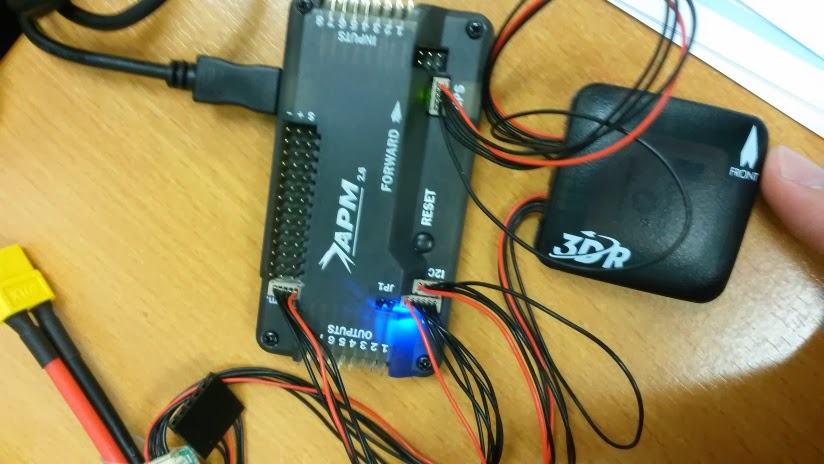Hi all! This week's update is kinda late. But here is a summary of all our work done for the past week:-
1) Design of Experiment
Angus and JD, the Systems Engineer and Controls Engineer respectively, were busy trying to set up a static bench test to analyse propeller performance. The experiment is initially designed to use weighing machine to measure lifting force/thrust (from weight to newtons). But through Angus's improvisation, he offered the dead weights from his personal training set (see Figure 11 below).
 |
| Figure 11: Dead weights from Angus's personal training set |
Angus was so excited to use the 3D printer that he created a video introducing it.
Video 2: Angus getting excited about 3D printing.
The first test rig was 3D-printed without screw threads. This led to a lot of frustration and dampened the initially excited mood from our team. Subsequently, the design was slightly changed and printed again. As you can see in Figures 12-14, thankfully this time it worked well!
 |
| Figure 12: 3-D printer in action |
 |
| Figure 13: Motor mounting |
Figure 14: 2nd test rig (finally working well)
For safety reasons, Dr Ahmed (Lead Supervisor) and Dr Michael (Controls Supervisor) helped us to set up the experiment (see Figure 15 below).
 |
| Figure 15: Dr Michael and Dr Ahmed (left and centre of picture respectively) |
2) Autonomous Batteries Changer
Jeremy started to print parts to conceptualize his ideas. In Figure 16 below, the battery carriage is made up of 2 parts. The red one is to be attached onto the QR's centre frame base. Its 'T' design allows it to be slotted onto the white part, which will be holding the battery and copper strips. The only drawback of the printed parts, which otherwise works well, is the very tight tolerance between the touching surfaces of the 'T' design.
 |
| Figure 16: Printed battery carriage |
3) Protective Crash Cage
This week, 3 concepts were generated based on 3 interesting principles that can be found in the world today.
In Figure 17 below, the concept design is based on the working principle of a gomboc. Gombok is a convex three-dimensional homogeneous body. The stable and unstable points of equilibrium will help to keep the structure recover to its initial position.
 |
| Figure 17: Design based on gomboc principle |
In Figure 18, the possibility of using the gyroscopes is explored. The gyroscope has the capability of maintaining the QR's orientation using the principles of angular momentum. The whole frame structure will then be mounted onto the inner circle. The inner circle will then change the response to an external torque in the z-axis direction.
 |
| Figure 18: Design based on gyroscope principle |
In Figure 19, there is a possibility of using individual protection cages to each propellers. The principle of self-recovery in this structure depend on the four individual motor operating at each universal joint. But this is certainly a disadvantage as it will cause the whole protection cage to be very heavy. Knowing that lightweight is significantly important in the overall design, this concept may not be very suitable.
 |
| Figure 19: Individual propeller protective cage |
These concepts generation will be followed by material analysis and selection, which will be updated next week. =)
4) Terrestrial Drive System
With evaluation for the three different
concepts, the four wheels and two wheels concepts are not very feasible as the
motor systems that are required to drive the wheels, will be very heavy for the
QR. The most ideal concept that can be used for the QR is the
cylindrical rolling cage concept.
 |
| Figure 20: CAD drawing of the rolling cage design |
Figure 20 shows the CAD
drawing of the cylindrical cage. The cylindrical cage will be surrounding the
QR and acts as a protective cover and a terrestrial driving system.
This concept is not drawn to exact size but rather has been scaled down for 3D
printing purpose. With the 3D printing, it allowed the user to visualise the
concept to see if it is workable.
It consists of four cylindrical rods, two
side structures and two shaft structures. The four cylindrical rods are used to
connect the two side structures together. The two shaft structures are required
to be attached to the bottom of the main QR’s structure. They will allow
the side structures to rotate and hence the cylindrical cage will be able to
rotate when the QR is travelling on the ground. If the parts are faulty,
the structure allows easier replacement of the components.
5) Mainframe Design
3 shapes and materials were used to evaluate using evaluation matrix, material selection index, and shape factor for use on the beams of the QR arms. In addition, these 3 designs were CAD modeled and simulated on SolidWorks based on the cantilever beam analysis with 30N end point load. Figures 21 and 22 shows examples of the simple simulation analysis on SolidWorks.
 |
| Figure 21: Maximum stress acting on beam |
 |
| Figure 22: Maximum deflection of beam |
 |
| Figure 23: Results tabulation |
Based on findings, ideally for a pure cantilever beam, it is best to construct the beam out of Carbon Fibre composites with I-beam cross-section. However, it may be difficult to use carbon fibre composites to construct the fillet between the I-beam's flange and web. In addition, the QR's flight will cause the beams to be subjected to load on the Ix and Iy axis, as well as torsion loads. Thus in this application, carbon fibre composites is best used with circular cross section tubes.
In summary, we are all aiming to develop concepts to integrate and interface all different modules together, bearing in mind our concept freeze date is on the 3rd of March.








.jpg)

